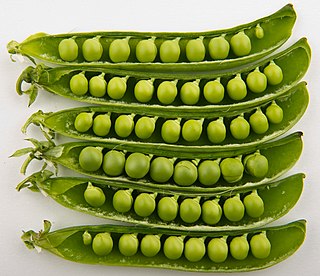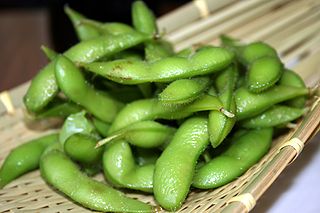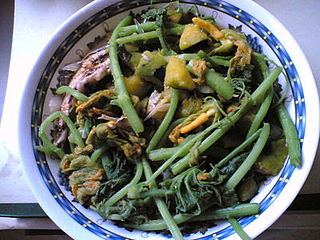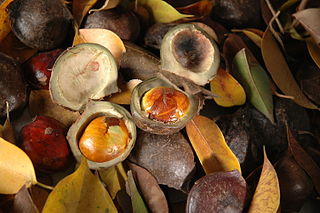
A bean is the seed of several plants in the family Fabaceae, which are used as vegetables for human or animal food. They can be cooked in many different ways, including boiling, frying, and baking, and are used in many traditional dishes throughout the world.

Turkish cuisine is the cuisine of Turkey and the Turkish diaspora. It is largely the heritage of Ottoman cuisine, which can be described as a fusion of Mediterranean, Balkan, Middle Eastern, Central Asian and Eastern European cuisines. Turkish cuisine has in turn influenced those and other neighbouring cuisines, including those of Southeast Europe (Balkans), Central Europe, and Western Europe. The Ottomans fused various culinary traditions of their realm taking influences from Mesopotamian cuisine, Arab cuisine, Persian cuisine, Armenian cuisine, Greek cuisine, Levantine cuisine, Egyptian cuisine, Balkan cuisine, along with traditional Turkic elements from Central Asia, creating a vast array of specialities. Turkish cuisine also includes dishes invented in the Ottoman palace kitchen.

The pea is most commonly the small spherical seed or the seed-pod of the flowering plant species Lathyrus oleraceus. Each pod contains several peas, which can be green or yellow. Botanically, pea pods are fruit, since they contain seeds and develop from the ovary of a (pea) flower. The name is also used to describe other edible seeds from the Fabaceae such as the pigeon pea, the cowpea, and the seeds from several species of Lathyrus.

Edamame is a Japanese dish prepared with immature soybeans in the pod. The pods are boiled or steamed and may be served with salt or other condiments. The dish has become popular across the world because it is rich in vitamins, dietary fiber, and isoflavones. When the beans are outside the pod, the term mukimame is also sometimes used in Japanese. Edamame are a common side dish in Japanese cuisine and as an appetizer to alcoholic beverages such as beer or shōchū. As an ingredient Edamame are found in both sweet and savory dishes such as takikomi gohan, tempura, and zunda-mochi.

The mung bean, alternatively known as green gram, maash ٫ mūng, monggo, đậu xanh, pesalu, kacang hijau or munggo (Philippines), is a plant species in the legume family. The mung bean is mainly cultivated in East, Southeast and South Asia. It is used as an ingredient in both savoury and sweet dishes.

Phaseolus coccineus, known as runner bean, scarlet runner bean, or multiflora bean, is a plant in the legume family, Fabaceae. Another common name is butter bean, which, however, can also refer to the lima bean, a different species.

A lima bean, also commonly known as the butter bean, sieva bean, double bean or Madagascar bean is a legume grown for its edible seeds or beans.

Phaseolus vulgaris, the common bean, is a herbaceous annual plant grown worldwide for its edible dry seeds or green, unripe pods. Its leaf is also occasionally used as a vegetable and the straw as fodder. Its botanical classification, along with other Phaseolus species, is as a member of the legume family Fabaceae. Like most members of this family, common beans acquire the nitrogen they require through an association with rhizobia, which are nitrogen-fixing bacteria.

The winged bean, also known as cigarillas, goa bean, four-angled bean, four-cornered bean, manila bean, princess bean, star bean, kamrangi bean, pea, dragon bean, is a tropical herbaceous legume plant.

The asparagus bean is a legume cultivated for its edible green pods containing immature seeds, like the green bean. It is also known as: yardlong bean, pea bean, long-podded cowpea, Chinese long bean, snake bean, bodi, and bora. Despite the common name of "yardlong", the pods are actually only about half a yard long, so the subspecies name sesquipedalis is a more accurate approximation.

Green beans are young, unripe fruits of various cultivars of the common bean, although immature or young pods of the runner bean, yardlong bean, and hyacinth bean are used in a similar way. Green beans are known by many common names, including French beans, string beans, and snap beans or simply "snaps." In the Philippines, they are also known as "Baguio beans" or "habichuelas" to distinguish them from yardlong beans.

Cellophane noodles, or fensi, sometimes called glass noodles, are a type of transparent noodle made from starch and water. A stabilizer such as chitosan may also be used.

Parkia speciosa, the bitter bean, twisted cluster bean, sator bean, or stink bean, is a plant of the genus Parkia in the family Fabaceae. It bears long, flat edible beans with bright green seeds the size and shape of plump almonds which have a rather peculiar smell, similar to, but stronger than that of the shiitake mushroom, due to sulfur-containing compounds also found in shiitake, truffles and cabbage.

Dinengdeng is a dish of the Ilocano people of the Philippines, similar to pinakbet. It is classified as a bagoong soup-based dish. Unlike pinakbet, dinengdeng contains fewer vegetables more soup base.

Archidendron pauciflorum, commonly known as djenkol, jengkol or jering is a species of flowering tree in the pea family, Fabaceae. It is native to Southeast Asia, where the seeds are a popular dish. They are mainly consumed in Indonesia, Thailand, Myanmar, and Vietnam and prepared by frying, boiling, or roasting and are also eaten raw. The beans are mildly toxic due to the presence of djenkolic acid, an amino acid which causes djenkolism. The beans and leaves of the djenkol tree are traditionally used for medicinal purposes such as purifying the blood. To date, djenkol is traded on local markets only.

Belizean cuisine is an amalgamation of all ethnicities in the nation of Belize and their respectively wide variety of foods. Breakfast often consists of sides of bread, flour tortillas, or fry jacks that are often homemade and eaten with various cheeses. All are often accompanied with refried beans, cheeses, and various forms of eggs, etc. Inclusive is also cereal along with milk, coffee, or tea.
Pea beans are several types of common food plants producing beans:

Sinabawang gulay, usually anglicized as Filipino vegetable soup, is a Filipino vegetable soup made with leafy vegetables and various other vegetables in a broth seasoned with seafood stock or patis. The ingredients of the dish can vary widely. It is eaten on its own or over white rice.

The production of fenugreek in India is marked by its dominant position in world production and export. Within India Rajasthan accounts for its largest cropped area and production. The fenugreek plant is an annual herbaceous forage legume with aroma, which is used for food in the form of its seeds as spices, and its leaves as a vegetable. It is also used as a medicinal herb in several Ayurvedic formulations for treatment of dry skin, boils, hair loss and so forth.




















